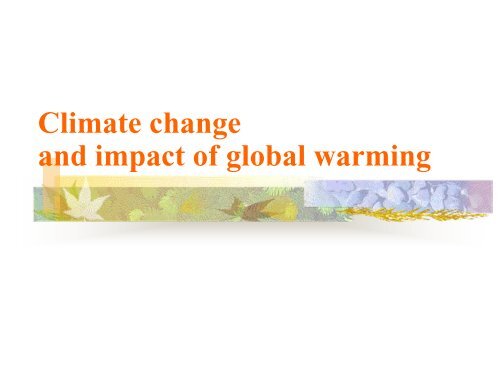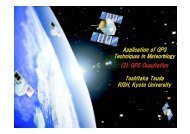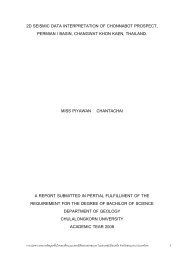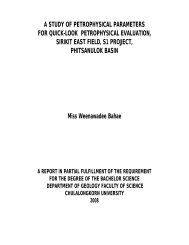Climate change and impact of global warming
Climate change and impact of global warming
Climate change and impact of global warming
You also want an ePaper? Increase the reach of your titles
YUMPU automatically turns print PDFs into web optimized ePapers that Google loves.
<strong>Climate</strong> <strong>change</strong><strong>and</strong> <strong>impact</strong> <strong>of</strong> <strong>global</strong> <strong>warming</strong>
<strong>Climate</strong> <strong>change</strong>Defined as a <strong>change</strong> in anystatistical property <strong>of</strong> the atmosphere ,such as a <strong>change</strong> in mean temperature.
Comparison <strong>of</strong> two sea level reconstructions during thelast 500 Myr. The scale <strong>of</strong> <strong>change</strong> during the lastglacial/interglacial transition is indicated with a black bar.Note that over most <strong>of</strong> geologic history, long-termaverage sea level has been significantly higher thantoday
Changes through geologic timeIn the depths <strong>of</strong> the last glaciation, around 20,000years ago,l<strong>and</strong> ice covered much more area asseen in the map above.Sea level was about 120
Average Global Temperature, 1880-2004Average <strong>global</strong> temperature 1880-2004Degrees celsius14.814.614.414.21413.813.613.413.21860 1880 1900 1920 1940 1960 1980 2000 2020YearSource: Goddard Institute for Space Studies, NASA Goddard Space FlightCenter, Earth Sciences Directorate, "Global Temperature Anomaliesin .01 C," , updated January 2005.
Recent sea level riseWarmer temperatures are expected to raise sea level byexp<strong>and</strong>ing ocean water, melting mountain glaciers, <strong>and</strong>melting parts <strong>of</strong> the Greenl<strong>and</strong> Ice Sheet. Warmertemperatures also increase precipitation, as describedbelow. Snowfall over Greenl<strong>and</strong> <strong>and</strong> Antarctica isexpected to increase by about 5 percent for every 1°F<strong>warming</strong> in temperatures.
Why are <strong>global</strong> <strong>warming</strong> specialists watching theArctic so closely?Since 1979, the size<strong>of</strong> the summer polarice cap has shrunkmore than 20 percent.(Illustration fromNASAที่มาhttp://www.nrdc.org/<strong>global</strong><strong>warming</strong>/qthinice.aspThe Arctic is <strong>global</strong> <strong>warming</strong>'s canary in the coal mine. It'sa highly sensitive region, <strong>and</strong> it's being pr<strong>of</strong>oundly affectedby the changing climate. The polar ice cap as a whole isshrinking. Images from NASA satellites show that the area<strong>of</strong> permanent ice cover is contracting at a rate <strong>of</strong> 9 percenteach decade. If this trend continues, summers in theArctic could become ice-free by the end <strong>of</strong> the century.
Impacts <strong>of</strong> <strong>global</strong> sea level riseMelting glaciers <strong>and</strong> l<strong>and</strong>-based icesheets also contribute to rising sealevels, threatening low-lying areasaround the globe with beach erosion,coastal flooding,
Global sea level rise as anindicator <strong>of</strong> climate <strong>change</strong>• <strong>global</strong> <strong>warming</strong> will cause both expansion<strong>of</strong> the ocean <strong>and</strong> <strong>change</strong>s <strong>of</strong> circulation [Church et al., 1991]. In addition, themelting <strong>of</strong> small glaciers, while difficult toquantify, is also significant [ Meier, 1984].These two effects together can account forabout one mm per year <strong>of</strong> sea level riseover the last century
SELECTED EXAMPLES OF ICE MELT AROUND THE WORLDName Location Measured LossArctic SeaIceGreenl<strong>and</strong>Ice SheetArctic OceanGreenl<strong>and</strong>Year-round ice area declined by 9 percent perdecade from 1978 to 2003. The smallestsummer ice extents in recorded history alloccurred in the past three years (15 percentbelow average in 2002, 12 percent in 2003,<strong>and</strong> 13 percent in 2004). Summers could beice free by the end <strong>of</strong> the century.Greenl<strong>and</strong>'s melt region exp<strong>and</strong>ed by 17percent between 1992 <strong>and</strong> 2002. Annualice loss form Greenl<strong>and</strong> is sufficient toraise the <strong>global</strong> sea level by an average<strong>of</strong> 0.13 millimeters per year.• Source: Compiled by Danielle Murray, Earth Policy Institute, February 2005, fromsources including Worldwatch Institute, WWF, Arctic <strong>Climate</strong> Impact Assessment, NASA,National Snow <strong>and</strong> Ice Data Center.
http://www.met<strong>of</strong>fice.com/research/hadleycentre/models/modeldata.html
http://www.met<strong>of</strong>fice.com/research/hadleycentre/models/modeldata.html
http://www.met<strong>of</strong>fice.com/research/hadleycentre/models/modeldata.html
The <strong>impact</strong>s <strong>of</strong> sea-level rise relate withThail<strong>and</strong>Contributor: Robert Nicholls, Middlesex University, LondonSea level will be about 40 cm higherthan today by the 2080s, <strong>and</strong> this isestimated to increase the annualnumber <strong>of</strong> people flooded from 13million to 94 million. Global <strong>warming</strong>causes sea level to rise by thermalexpansion <strong>of</strong> the ocean waters <strong>and</strong> themelting <strong>of</strong> l<strong>and</strong>-based ice.
Calculations are made <strong>of</strong> the average number<strong>of</strong> people who are estimated to experienceflooding per year by storm surges.• Average annual<strong>global</strong> number <strong>of</strong>people flooded forthe 2020s, 2050s<strong>and</strong> 2080s underthe threeemissionsscenarios:unmitigated (red),stabilisation at 750ppm (blue) <strong>and</strong> at550 ppm CO2(green). Alsoshown are thenumbers withoutclimate <strong>change</strong>(grey).
The total annual number <strong>of</strong> people flooded in the2080shttp://www.met-<strong>of</strong>fice.gov.uk/research/hadleycentre/pubs/brochures/B1999/imp• The total annualnumber <strong>of</strong>people floodedin the 2080s,along thecoastlinesshown
ลมมรสุมกับภูมิอากาศของประเทศไทยประเทศไทยอยูภายใตอิทธิพลของมรสุมสองชนิด คือ มรสุมตะวันตกเฉียงใต และมรสุมตะวันออกเฉียงเหนือ• มรสุมตะวันตกเฉียงใต พัดปกคลุมประเทศไทยระหวางกลางเดือนพฤษภาคมถึง กลางเดือนตุลาคม• มรสุมตะวันออกเฉียงเหนือ หลังจากหมดอิทธิพลของมรสุมตะวันตกเฉียงใตแลว ประมาณกลางเดือนตุลาคมจะมีมรสุมตะวันออกเฉียงเหนือพัดปกคลุมประเทศไทยจนถึงกลางเดือนกุมภาพันธ
ฤดูมรสุมตะวันออกเฉียงเหนือ ที่มา:กรมอุตุนิยมวิทยารูปแบบทางเดินพายุหมุนเขตรอนที่เคลื่อนที่เขาสูประเทศไทยเดือนพฤศจิกายน
ฤดูมรสุมตะวันตกเฉียงใตที่มา:กรมอุตุนิยมวิทยารูปแบบทางเดินพายุหมุนเขตรอนที่เคลื่อนที่เขาสูประเทศไทยเดือนพฤษาคม
พายุหมุนเขตรอนพายุหมุนเขตรอน คือพายุที่กอตัวเหนือมหาสมุทรในเขตรอน มีความรุนแรง 3 ระดับคือพายุดีเปรสชั่น พายุโซนรอนและพายุเฮอรริเคน (ถาเกิดในมหาสมุทรแอตแลนติคเหนือ) หรือไตฝุน (ถาเกิดทางตะวันตกของมหาสมุทรแปซิฟกเหนือและในทะเลจีนใต)
ํพายุหมุนเขตรอน(ตอ)• มหาสมุทรแปซิฟกเหนือดานตะวันตก ทางตะวันตกของลองจิจูด 170ตะวันออก เมื่อมีกําลังแรงสูงสุด เรียกวา "ไตฝุน" เกิดมากที่สุดในเดือนกรกฎาคม สิงหาคม กันยายน และตุลาคม• มหาสมุทรแอตแลนติกเหนือแถวทะเลแคริบเบียนและอาวเม็กซิโก เรียกวา"เฮอรริเคน" เกิดมากในเดือนสิงหาคม กันยายน และตุลาคม• มหาสมุทรแปซิฟกเหนือ ฝงตะวันตกของประเทศเม็กซิโก เรียกวา "เฮอรริเคน"• บริเวณมหาสมุทรอินเดียเหนือ อาวเบงกอล เรียกวา "ไซโคลน"• บริเวณมหาสมุทรอินเดียเหนือ ทะเลอาระเบีย เรียกวา "ไซโคลน"• มหาสมุทรอินเดียใต ตะวันตกของลองจิจูด 90 ํ ตะวันออก เรียกวา "ไซโคลน"• มหาสมุทรอินเดียใต ตะวันตกเฉียงเหนือของทวีปออสเตรเลีย เรียกวา "วิลลี่วิลลี่"
เอลนีโญ และ ลานีญาภาพที่ 1 สภาวะปกติ ภาพที่ 2 ปรากฏการณเอลนีโญ ภาพที่ 3 ลานีญาhttp://www.nectec.or.th/haze/
• เอลนีโญ (EL NINO) คือปรากการฎการอุนขึ้นอยางผิดปกติของน้ําทะเลบริเวณตอนกลางและตะวันออกของมหาสมุทรแปซิฟกเขตรอน ซึ่งเกิดจากการออนกําลังลงของลมคา (trade wind) ตามปกติเหนือนานน้ํามหาสมุทรแปซิฟกเขตรอนหรือมหาสมุทรแปซิฟกเขตศูนยสูตรจะมีลมคาตะวันออกพัดปกคลุมเปนประจํา ลมนี้จะพัดพาผิวหนาน้ําทะเลที่อุนจากทางตะวันออก (บริเวณชายฝงประเทศเอกวาดอร เปรู และชิลีตอนเหนือ) ไปสะสมอยูทางตะวันตก (ชายฝงอินโดนีเซีย และออสเตรเลีย) ทําใหบรรยากาศเหนือบริเวณแปซิฟกตะวันตกมีความชื้น และมีการกอตัวของเมฆและฝนบริเวณตะวันออกและตะวันออกเฉียงใตของเอเชีย รวมทั้งประเทศตาง ๆ ที่เปนเกาะอยูในแปซิฟกตะวันตกขณะที่ทางตะวันออกของแปซิฟกเขตศูนยสูตรมีการไหลขึ้นของน้ําเย็นระดับลางขึ้นไปยังผิวน้ําและทําใหเกิดความแหงแลงบริเวณชายฝงอเมริกาใต แตเมื่อลมคาตะวันออกมีกําลังออนกวาปกติ ลมที่พัดปกคลุมบริเวณดานตะวันออกของปาปวนิวกินี (ปาปวนิวกินี คือ เกาะที่ตั้งอยูบริเวณเสนศูนยสูตรทางแปซิฟกตะวันตกเหนือทวีปออสเตรเลีย) จะเปลี่ยนทิศทางจากตะวันออกเปนตะวันตก ทําใหเกิดคลื่นใตผิวน้ําพัดพาเอามวลน้ําอุนที่สะสมอยูบริเวณแปซิฟกตะวันตกไปแทนที่น้ําเย็นทางแปซิฟกตะวันออก เมื่อมวลน้ําอุนไดถูกพัดพาไปถึงแปซิฟกตะวันออก (บริเวณชายฝงประเทศเอกวาดอร) ก็จะรวมเขากับผิวน้ํา ทําใหผิวหนาน้ําทะเลบริเวณนี้อุนขึ้นกวาปกติ และน้ําอุนนี้จะคอย ๆ แผขยายพื้นที่ไปทางตะวันตกถึงตอนกลางของมหาสมุทร สงผลใหบริเวณที่มีการกอตัวของเมฆและฝนซึ่งปกติจะอยูทางตะวัน ตกของมหาสมุทรเปลี่ยนแปลงไปอยูที่บริเวณตอนกลางและตะวันออก บริเวณดังกลาวจึงมีฝนตกมากกวาปกติ ในขณะที่แปซิฟกตะวันตกซึ่งเคยมีฝนมากจะมีฝนนอยและเกิดความแหงแลง• ลานีญา (La Nina) คือ ปรากฏการณที่กลับกันกับเอลนีโญ (EL NINO) กลาวคือ อุณหภูมิผิวน้ําทะเลบริเวณตอนกลางและตะวันออกของแปซิฟกเขตศูนยสูตรมีคาต่ํากวาปกติ เนื่องจากลมคาตะวันออกเฉียงใตมีกําลังแรงมากกวาปกติ จึงพัดพาผิวน้ําทะเลที่อุนจากตะวันออกไปสะสมอยูทางตะวันตกมากยิ่งขึ้น ทําใหบริเวณดังกลาวซึ่งเดิมมีอุณหภูมิผิวน้ําทะเลและระดับน้ําทะเลสูงกวาทางตะวันออกอยู แลวยิ่งมีอุณหภูมิและระดับน้ําทะเลสูงขึ้นไปอีก ปรากฏการณลานีญาเกิดขึ้นไดทุก 2– 3 ป และปกติจะเกิดขึ้นนานประมาณ 9 – 12 เดือน แตบางครั้งอาจปรากฏอยูไดนานถึง 2 ป• ปรากฏการณ เอลนิโญและลานีญา จะแปรปรวนตามกัน โดยเปนปรากฏการณที่มีลักษณะตรงขามกันเกิดขึ้น หรือเรียกวา(EL NINO-SOUTHERN-OSCILLATION หรือ ENSO )
•1997-98 El Niño Animationhttp://www.elnino.noaa.gov/lanina.html
1998-99 La Niña Animationhttp://www.elnino.noaa.gov/lanina.html
Impact <strong>of</strong> El Niño on Global Grain Production•Late-arriving rains in Indonesia <strong>and</strong> dryness inSoutheast Asia•Below-normal early-season rainfall in southernAfrica•Dry summer in Central America•Warm winter weather in Canadian Prairies <strong>and</strong>northern United States•Above-normal rainfall in southern California<strong>and</strong> southern United States
ความสัมพันธทั่วไประหวางพายุหมุนเขตรอนกับเอลนีโญภายในเขตรอนชวงที่เกิดเอลนีโญ การขยับตัวไปของบริเวณที่มีพายุฝนฟาคะนองจากแถบประเทศอินโดนีเซียไปยังตอนกลางของมหาสมุทรแปซิฟกปกติจะทําใหเกิดความแหงแลงผิดปกติบริเวณประเทศอินโดนีเซียฟลิปปนสและทางตอนเหนือของประเทศออสเตรเลียตลอดทุกฤดูกาลเชื่อวา• เอลนีโญเปนตัวลดการกอตัวของพายุเฮอรริเคนในมหาสมุทรแอตแลนติก• ลานีญา (สภาวะที่ผิวน้ําทะเลในมหาสมุทรแปซิฟกแถบศูนยสูตรเย็นลง)เอื้อตอการกอตัวของพายุเฮอรริเคน และเอลนีโญมีแนวโนมที่จะทําใหจํานวนพายุหมุนเขตรอนในบริเวณตอนกลางและทางตะวันออกของมหาสมุทรแปซิฟกเพิ่มจํานวนมากขึ้นhttp://www.dnp.go.th/ForestFire/news/elnino.htm
Malaysia, Thail<strong>and</strong>, <strong>and</strong> Philippines: InMalaysia, rainfall has been belownormal but adequate for riceproduction. In Thail<strong>and</strong>, below normalrainfall has lowered water reserves forthe second rice crop. In the Philippines,localized dryness has reduced corn <strong>and</strong>rice yields.
http://iri.columbia.edu/research/ENSO/tables/thai.htmlEl Niño Impacts:Rainfall AnomaliesTable 1: Thail<strong>and</strong> (10N-21N; 97E-108E)La Niña Impacts: Rainfall AnomaliesTable 2: Thail<strong>and</strong> (10N-21N; 97E-108E)El Nino ImpactLa Nina ImpactRainfall anomaliescm/month6420-21880 1900 1920 1940 1960 1980 2000-4-6-8yearEl Niño years with below average rain = 50%Rainfall anomaliescm/month6420-21880 1900 1920 1940 1960 1980 2000-4-6-8-10yearLa Niña years with above average rain = 40%Non-ENSO ImpactRainfall anomaliesacm/month64201880 1900 1920 1940 1960 1980 2000-2-4yearNon-ENSO Impacts: RainfallAnomaliesTable 3: Thail<strong>and</strong> (10N-21N; 97E-108E)Non-ENSO years with below average rain = 40%
อางอิง• http://www.nrdc.org/<strong>global</strong><strong>warming</strong>/qthinice.asp• http://www.met<strong>of</strong>fice.com/research/hadleycentre/models/modeldata.html• http://www.dnp.go.th/ForestFire/news/elnino.htm• http://www.giss.nasa.gov/data• http://www.fas.usda.gov/cmp/highlights/elnino.html• http://www.elnino.noaa.gov/lanina.html• http://www.pmel.noaa.gov/tao/elnino/1997.html• http://www.nectec.or.th/haze/• http://iri.columbia.edu/research/ENSO/tables/thai.html• http://www.met-<strong>of</strong>fice.gov.uk/research/hadleycentre/pubs/brochures/B1999/imp• http://www.met-<strong>of</strong>fice.gov.uk/research/hadleycentre/pubs/brochures/B1999/imp_sea_rise.htmlHome













